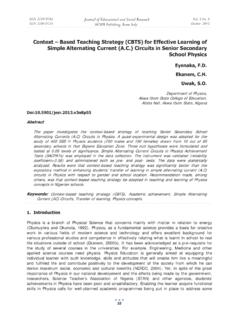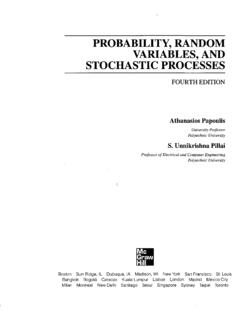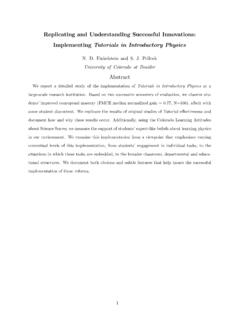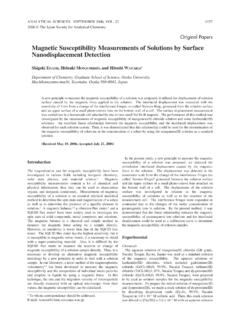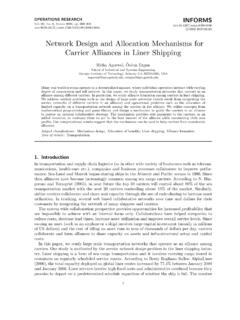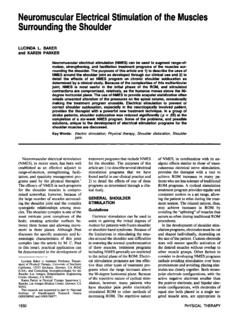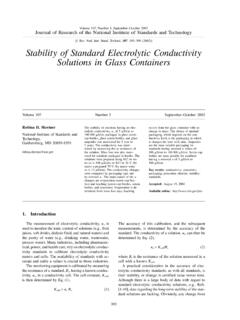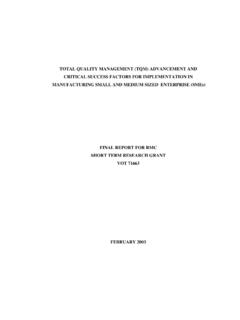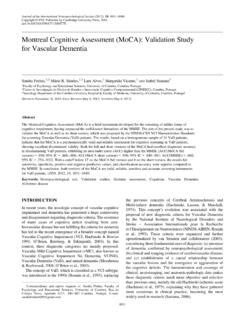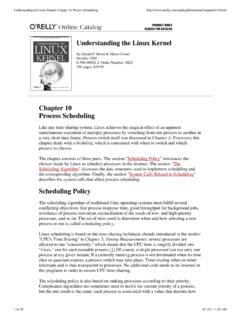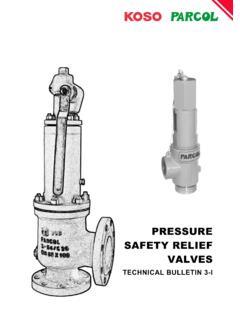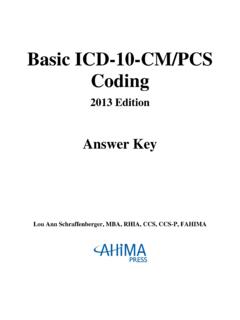Transcription of Materials for Gas Turbines – An Overview
1 13 Materials for Gas Turbines An Overview Nageswara Rao Muktinutalapati VIT University India 1. Introduction Advancements made in the field of Materials have contributed in a major way in building gas turbine engines with higher power ratings and efficiency levels. Improvements in design of the gas turbine engines over the years have importantly been due to development of Materials with enhanced performance levels. Gas Turbines have been widely utilized in aircraft engines as well as for land based applications importantly for power generation. Advancements in gas turbine Materials have always played a prime role higher the capability of the Materials to withstand elevated temperature service, more the engine efficiency; Materials with high elevated temperature strength to weight ratio help in weight reduction. A wide spectrum of high performance Materials - special steels, titanium alloys and superalloys - is used for construction of gas Turbines .
2 Manufacture of these Materials often involves advanced processing techniques. Other material groups like ceramics, composites and inter-metallics have been the focus of intense research and development; aim is to exploit the superior features of these Materials for improving the performance of gas turbine engines. The Materials developed at the first instance for gas turbine engine applications had high temperature tensile strength as the prime requirement. This requirement quickly changed as operating temperatures rose. Stress rupture life and then creep properties became important. In the subsequent years of development, low cycle fatigue (LCF) life became another important parameter. Many of the components in the aero engines are subjected to fatigue- and /or creep-loading, and the choice of material is then based on the capability of the material to withstand such loads.
3 Coating technology has become an integral part of manufacture of gas turbine engine components operating at high temperatures, as this is the only way a combination of high level of mechanical properties and excellent resistance to oxidation / hot corrosion resistance could be achieved. The review brings out a detailed analysis of the advanced Materials and processes that have come to stay in the production of various components in gas turbine engines. While there are thousands of components that go into a gas turbine engine, the emphasis here has been on the main components, which are critical to the performance of the engine. The review also takes stock of the R&D activity currently in progress to develop higher performance Materials for gas turbine engine application. On design aspects of gas turbine engines, the reader is referred to the latest edition of the Gas Turbine Engineering Handbook (Boyce, 2006).
4 Advances in Gas Turbine Technology 294 2. Compressor parts for aircraft engines Titanium alloys Titanium, due to its high strength to weight ratio, has been a dominant material in compressor stages in aeroengines. Titanium content has increased from 3 % in 1950s to about 33% today of the aeroengine weight. Unlike predictions made for requirements of ceramic and metal matrix composites for aeroengines, predictions made for titanium alloys have come true or even surpassed. High temperature titanium alloys have found extensive application in aeroengines. Ti-6Al-4V is used for static and rotating components in gas turbine engines. Castings are used to manufacture the more complex static components. Forgings are typically used for the rotating components. For example, the alloy is used for fan disc and low pressure compressor discs and blades for the Pratt and Whitney 4084 engine.
5 The alloy is used in the cooler compressor stages up to a maximum temperature of about 315 oC. Ti-8Al-1Mo-1V is used for fan blades in military engines (Bayer, 1996). The alloys 685 ( ) and 829 ( ) are used in many current European aeroengines such as RB2111, 535E4 in fully beta heat treated condition to maximize creep resistance (Gogia, 2005). Alloy 834 ( ), a relatively recent grade, in contrast is used in + condition, with a 5-15% equiaxed in the microstructure to optimize both creep and fatigue strength (Gogia, 2005). The alloy was aimed at replacing the Alloys 685 and 829 preferred in European jet engines. Alloy 834 is used as a compressor disc material in the last two stages of the medium-pressure compressor, and the first four stages of the high pressure compressor in variants of the Rolls-Royce Trent series commercial jet engine.
6 The Ti-1100 ( ), a competitive alloy to IMI834, is designed to be used in the heat treated condition. The alloy is under evaluation by Allison Gas Turbine Engines for higher thrust versions of their 406/GMA3007/GMA2100 family of engines, primarily for castings (Gogia, 2005). The alloy has a claimed use temperature of 600 oC. IN US, Ti6-2-4-2 (Ti-6Al-2Sn-4Zr-2Mo) is the preferred high temperature alloy for jet engine applications. A variant of this alloy, Ti6-2-4-2S is also commercially available. The S denotes addition of % Si to improve the creep resistance. It is used for rotating components such as blades, discs and rotors at temperatures up to about 540 oC (Bayer, 1996). It is used in high pressure compressors at temperatures too high for Ti-6-4, above about 315 oC, for structural applications. Today, the maximum temperature limit for near- alloys for elevated temperature applications is about 540 oC.
7 This temperature limitation for titanium alloys mean the hottest parts in the compressor, the discs and blades of the last compressor stages, have to be manufactured from Ni-based superalloys at nearly twice the weight. Additionally, problems arise associated with the different thermal expansion behavior and the bonding techniques of the two alloy systems. Therefore enormous efforts are underway to develop a compressor made completely of titanium. Titanium alloys are required that can be used at temperatures of 600 oC or higher. This has been the impetus for extensive research and development work in the area of elevated temperature titanium alloys. Table 1 gives the chemical composition and the maximum service temperature of various grades of titanium alloys mentioned above. Figure 1 shows schematically the relative creep capability of these grades in the form of a Larson Miller plot.
8 The reader is referred to some excellent reviews on use of titanium alloys in gas turbine engines (Bayer, 1998; Gogia, 2005). The technical guide on titanium published by ASM International (Donachie, 2000) also gives much information on titanium as a gas turbine material. Materials for Gas Turbines An Overview 295 Fig. 1. Relative creep capability of titanium alloys used for compressor parts in the form of a Larson Miller plot (Schematic). 3. Compressor blading Materials for land based gas Turbines Special steels Until recently, all production blades for compressors are made from 12% chromium containing martensitic stainless steel grades 403 or 403 Cb (Schilke, 2004). Corrosion of compressor blades can occur due to moisture containing salts and acids collecting on the blading. To prevent the corrosion, GE has developed patented aluminum slurry coatings for the compressor blades.
9 The coatings are also meant to impart improved erosion resistance to the blades. During the 1980 s, GE introduced a new compressor blade material, GTD-450, a precipitation hardened martensitic stainless steel for its advanced and uprated machines (Schilke, 2004). Without sacrificing stress corrosion resistance, GTD-450 offers increased tensile strength, high cycle fatigue strength and corrosion fatigue strength, compared to type 403. GTD-450 also possesses superior resistance to acidic salt environments to type 403, due to higher concentration of chromium and presence of molybdenum (Schilke, 2004). Grade designation Nominal chemical composition Maximum service temperature (oC) Ti64 Ti-6Al-4V 315 Ti811 Ti-8Al-1Mo-1V 400 Alloy 685 520 Alloy 829 550 Alloy 834 600 Ti1100 600 Ti6242 Ti-6Al-2Sn-4Zr-2Mo Ti6242S 540 Table 1.
10 Titanium alloys used for compressor parts in aircraft engines chemical composition and maximum service temperature Advances in Gas Turbine Technology 296 Table 2 gives the chemical composition of the different steel grades used for compressor blading. Grade Chemical composition Remarks AISI 403 Martensitic stainless steel AISI 403+Nb Martensitic stainless steel with Nb addition GTD-450 Precipitation hardening stainless steel Table 2. Compressor blade Materials for land based gas Turbines 4. Combustion hardware for aircraft and industrial gas Turbines (IGTs) Driven by the increased firing temperatures of the gas Turbines and the need for improved emission control, significant development efforts have been made to advance the combustion hardware, by way of adopting sophisticated Materials and processes.
